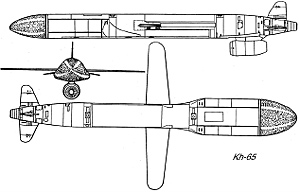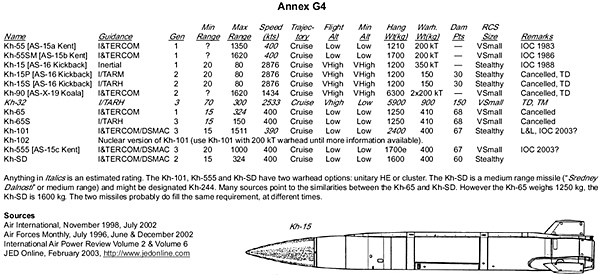 The Soviet Air Force lacked viable long-range bombers, able to make the trip to the US and return, until the Tu-95MS Bear H and Tu-160 Blackjack entered service in the 1980s.
Earlier aircraft lacked either the range, weapons or survivability against North American targets. The 88 Tu-95MS were developed as a low-risk project, to quickly get the Kh-55 [AS-15 Kent] missile in service in large numbers. One hundred Tu-160 were planned, although only 32 production versions were produced. In the 1980s, plans included the Mach 4 Tu-260 and Mach 6 Tu-360 to replace the Tu-160, and the ‘B-90’ (bomber for the 1990s) subsonic, stealthy flying wing to replace the Tu-95MS. The B-90 might have had the designation Tu-180 or perhaps Tu-202. New production Tu-22M-4s would supplement intermediate-range Tu-22M-3 [Backfire C]. The Tu-16 and Tu-22M-2 [Backfire B] were to be replaced by the low-observable Sukhoi T-60S, expected in service in 2003.
The Soviet Air Force lacked viable long-range bombers, able to make the trip to the US and return, until the Tu-95MS Bear H and Tu-160 Blackjack entered service in the 1980s.
Earlier aircraft lacked either the range, weapons or survivability against North American targets. The 88 Tu-95MS were developed as a low-risk project, to quickly get the Kh-55 [AS-15 Kent] missile in service in large numbers. One hundred Tu-160 were planned, although only 32 production versions were produced. In the 1980s, plans included the Mach 4 Tu-260 and Mach 6 Tu-360 to replace the Tu-160, and the ‘B-90’ (bomber for the 1990s) subsonic, stealthy flying wing to replace the Tu-95MS. The B-90 might have had the designation Tu-180 or perhaps Tu-202. New production Tu-22M-4s would supplement intermediate-range Tu-22M-3 [Backfire C]. The Tu-16 and Tu-22M-2 [Backfire B] were to be replaced by the low-observable Sukhoi T-60S, expected in service in 2003.
New weapons were also planned. These included the stealthy Kh-101 cruise missile. The Soviet Union saw stealth as a counter to the US SDI missile defence system. If the US ‘Star Wars’ program succeeded, it would threaten the viability of ballistic missiles. Low-observable cruise missiles would allow the USSR to retain survivable strategic deterrence weapons.
Meteorit and failure
The Soviet approach to missiles was largely by brute force. BNMs (‘Big Nasty Missile’) such as SS-N-12, SS-N-19, AS-3, AS-4 are fast and have long ranges, the 3M-25 Meteorit continued this trend.
The Meteorit family was to have consisted of the Kh-90 Meteorit-A [AS-X-19 Koala], carried by the Tu-95MA Bear, 3M25 Meteorit-M [SS-NX-24 Scorpion] from the Project 667M ‘Andromeda’ SSGN [Yankee Sidecar] and Meteorit-N [SSCX-5 Slingshot] from land launchers. The guidance was the familiar terrain comparison (TERCOM), and would have had plasma screening to reduce the RCS. The air-launched Meterorit-A was cancelled after some launch failures and the successes of the smaller, slower Kh-55 [AS-15 Kent]. The conversion of a Project 667A [Yankee SSBN], K-420, to Project 667M with 12 Meteorit-M went smoothly, with the submarine ready in November 1983.
Submerged speed was reduced to 23 knots. However, Meteorit-M and Meteorit-N were cancelled in 1989 due to continued launch failures and problems with the plasma screening technology.
‘Kent’ and ‘Kickback’
At the same time as Meteorit, work had started on a small, subsonic, terrain contour-following missile. Tests were very successful, inspired by US work in the same area. The Kh-55 [AS-15a Kent] entered service in 1983 on the Tu-95MS-6 Bear H. The later Tu-95MS-16 uses the Kh-55SM [AS-15b Kent], which has conformal fuel tanks for increased range. It was planned to use a short-range version, known as the Kh-65, on the Su-27M/Su-35. This missile never entered service.
The Kh-15 [AS-16 Kickback] is very similar to the US SRAM. It cruises at 40 km altitude and then dives onto the target at a steep angle. It entered service with the Tu-22M-3 [Backfire C] in 1988. Conventional ARM and antishipping versions, also to be used with the Su-27M/Su-35, were cancelled at the end of the Cold War.
Bombers for Oil
Following the breakup of the Soviet Union, aircraft stationed in member states of the former USSR were claimed by the new nations. In 1990, Russia had 23 Tu-95MS-16, 6 Tu-160 and 675 Kh-55/55SM. Ukraine had 5 Tu-95MS-6, 20 Tu-95MS-16, 19 Tu-160 and 1068 Kh-55/55SM. Kazakhstan had 27 Tu-95MS-6, 13 Tu-95MS-16 and 370 Kh-55SM; these were returned to Russia by 1994. In a series of talks through the 1990s, Russia agreed to forgive a portion of Ukraine’s gas debt in return for eight Tu-160, three Tu-95MS and 575 Kh-55/55SM missiles. The aircraft were transferred in 1999 and 2000.
Remaining Ukrainian bombers, including 12 Tu-160, and missiles were destroyed with US assistance. The low point of Russian strategic aviation in the 1990s was in 1998, with only two of the six Tu-160 serviceable.
The USAF 1991-1999
The USAF successfully used strategic bombers with conventional weapons during the 1990s. First in Desert Storm, and then later, strategic bombers were shown to have other uses besides a nuclear doomsday. The possibility of conventional as well as nuclear attacks on Russian soil forced the Russians to keep the MiG-31 Foxhound in service, rather than phasing it out.
Russian Strategic aviation began much-publicized exercises in 1998, which is the whole point of having strategic bombers. The final straw for Russia was the NATO bombing of Serbia in 1999. Western aircraft, combined with precision munitions, devastated ground targets. Russia needed modernized bombers to match NATO. Authorization was granted for Russian Air Force bombers to be upgraded. Russia threatened to use bombers against the Taliban in 1998 and 2000. This deterred any further aid from Afghanistan to the Chechen terrorists/freedom fighters. Tu-22M-3 were used in Chechnya, however at that time the Tu-95 and Tu-160 lacked conventional weapon capability. Estimates credit the Tu-95MS with three gravity nuclear bombs, the Tu-160 six. These weapons would have a yield of 5 and 20 MT.
Bomber Upgrades
As of mid-2002 the Russian Air Force has 120 Tu-22M-3 Backfire C (40-50 operational), 32 Tu-95MS-6 Bear H, 34 Tu-95MS-16 Bear H, 15 Tu-160 Blackjack and 504 ‘Kent’ missiles along with 20 Il-78 Midas tankers. The Russian Air Force has little need for continued production of new bombers, although three incomplete Tu-160s might be delivered in the near future. Rather than expensive production of what is considered older technology, existing aircraft will be updated.
The first stage of the update is planned to add conventional weapons to the existing Tu-22M-3, Tu-95MS and Tu-160 aircraft by 2003/2004. The second stage will add new avionics, including the Sigma weapons system, allowing the Kh-101 family of missiles to be used.
The Tu-22M-3 is planned to be updated to Tu-22M-5 standard with improved ECM, terrain following radar with an LPI mode. Weapons will include the antishipping Kh-32, an improved Kh-22 [AS-4 Kitchen] and possibly six to eight Kh-SD. Unless the Russians declare the Tu-22M-5 a heavy bomber to meet the requirements of the SALT I treaty, it probably will not carry the long range Kh-101.
Tu-22M-5 Backfire
Sensors: Modified PNA [Down Beat] radar with TF and LPI mode, RWR
1, 2 or 3 Kh-32
6 or 8 Kh-SD
4 Kh-101 (speculative)
Tu-95MS Bear H Bomber
Gun Atk: (0.4)
Man Rtng: .5/.5
Size/Signature: Large/Large
In Service: See
Remarks
Counterm: 3 rd Gen J&D
Bombsight: Ballistic
Sensors: Obzor [Clam Pipe] radar, RWR
Performance: Speed in Knots
| Throttle Setting | |||
|---|---|---|---|
| Altitude | Cruise | Full Mil | Reheat |
| V/Low: | 396 (1.7) | 410 (1.7) | -- |
| Med: | 396 (1.7) | 430 (1.8) | -- |
| High: | 448 (1.9) | 448 (1.9) | -- |
Ceiling: 10500 meters
Engine Type: TP
Endurance Data Inflight Refuel: Y/P
Cruise Range: 7100 nm
Int Fuel: 81670 kg
Ordnance Loadouts: Payload: 27200 kg
Def Guns: 2 GSh-23 23mm in tail turret
2 Kh-90 Meterorit-A [AS-X-19 Koala] – Tu-95MA
6 Kh-55 [AS-15a Kent] – Tu-95MS-6
16 Kh-55SM [AS-15b Kent] – Tu-95MS-16 (6 internal, 10 external)
8 Kh-101/102 – Tu-95MSM (external)
14 Kh-555/SD – Tu-95MSM (6 internal, 8 external)
Remarks:
Tu-95MA. Single prototype, might have carried 4 Kh-90 missiles in service. Cancelled in 1984. Tu-95MS-6. In Service: 1983 Tu-95MS-16. In Service: 1986. External Kh-55SM missiles later removed due to excessive drag and to comply with arms reduction treaties.
2000-2005: 35 Tu-95MS-16 to be updated to Tu-95MSM.
2005-2007: Tu-95MS-6 removed from service.
Tu-95MSM Bear
In Service: 2003. Radar updated with SAR and LPI modes. Might also receive R-77 [AA-12 Adder] AAM and 4 th Gen J&D in the future.
Few details are available on the exact nature of the Tu-160 update. It is known that 12 Kh-101/102/555/SD will be carried internally and the radar will have SAR and LPI modes. Replace the Kh-55 with any of the above weapons and add SAR and LPI modes to existing Obzor [Clam Pipe] radar until more information is available.
The Tu-22M-5, Tu-95MSM and upgraded Tu-160 are planned to continue in service till 2020 or possibly even 2035. The T-60S and B-90 might enter service after 2015, but this depends on Russian economic recovery.
New Weapons
The current Kh-55 and Kh-55MS will reach the end of their safe service life in 2003, although like just about everything in the Russian inventory these missiles could remain in service for some time. A family of missiles based on the Kh-101 will replace the ‘Kent’ series. The Kh-101 uses digital scene matching for precision guidance with a conventional warhead. A nuclear version with simplified guidance, Kh-102, is also planned for sometime in the future. The Kh-101 guidance will be used on updated Kh-55 missiles, producing the Kh-555.
A new short-range missile, the Kh-SD, will be produced sometime after the Kh-555 and Kh-101 enter service. This is probably not a version of the Kh-65, but a new design also with reduced RCS.
Finally, a 1500 kg GPS-guided bomb might also be developed. Assume this is a laser-guided KAB-1500L fitted with GPS guidance, until more is known. Assume this may replace any Kh-555 missile in updated aircraft loadouts. All of the missiles with TERCOM guidance cannot be retargeted in flight. TERCOM planning takes days and sometimes months (see the Tomahawk article on page 21 for more details). In H4 terms, launch points, flight paths, and targets must be selected before takeoff.
The Reality
Russian bomber pilots currently fly 10-20 hours per year; the average exercise in the late 1990s was 3 hours flight time. Aircraft are being kept flying by cannibalizing other aircraft. The upgrades will probably help the spares issue, however true long-range missions spread across all the pilots would be required for a viable bomber force.
The Russian can, with effort, operate. In May, Russian Tu-95 and Tu-160 aircraft exercised in the Indian ocean, firing two exercise Kent missiles.
Russian aircraft upgrades currently have a poor track record. The MiG-29SMT has made little to no progress. The Fencer upgrade was cancelled after 10 Su-24M2. A small number of Su-27UBM have been produced, but only 6 Su-30 exist and so on. Work on the Tu-95MSM upgrade has started. The Russians have noted the successes of USAF bombers since 1991, hence the bomber upgrade is a priority. The Kh-555 may enter service in 2003, along with the start of Kh-101 production. Time will tell whether these plans come to fruition.

BT
Back to The Naval Sitrep # 24 Table of Contents
Back to Naval Sitrep List of Issues
Back to MagWeb Master Magazine List
© Copyright 2003 by Larry Bond and Clash of Arms.
This article appears in MagWeb.com (Magazine Web) on the Internet World Wide Web.
Other military history and related articles are available at http://www.magweb.com